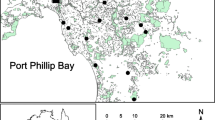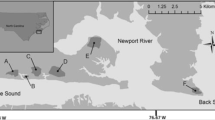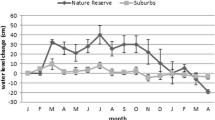Abstract
Turtles are long-lived organisms that require high survivorship to maintain stable populations. Additionally, turtles are thought to be particularly susceptible to negative effects associated with anthropogenic habitat modification such as increased presence of human-subsidized predators and increased road mortality. Recruitment may also be reduced in populations surrounded by developed landscapes because of high road densities which limits connectivity among habitats or because of limited nesting sites. To address the impacts of habitat development on turtle vital rates, we studied three species of semi-aquatic turtles, yellowbelly sliders (Trachemys scripta), eastern mud turtles (Kinosternon subrubrum), and common snapping turtles (Chelydra serpentina), in the urbanized Charlotte-metropolitan area of North Carolina. Mark-recapture data were analyzed in Program MARK using AIC model selection methods to evaluate models analyzing the effects of pond, sex, and time on both survivorship and recruitment rates. Our results yielded high survivorship estimates for sliders and snapping turtles (73–92.5% and 91.4–99.4%, respectively), indicating that these species were likely not severely affected by habitat modification. In contrast, mud turtles exhibited lower survivorship estimates (56.8–73.6%) than have been previously documented for this species, an observation we attribute to their reliance on terrestrial habitats where they may encounter greater densities of mesopredators in developed areas. Recruitment estimates indicated that most populations were subsidized by sizable additions each year, with the notable exception of snapping turtles whose movement may be limited by increased road densities. Our results suggest that anthropogenic habitat modification has species-specific effects and could imperil certain populations in urbanized areas.


Similar content being viewed by others
References
Baldwin EA, Marchand MN, Litvaitis JA (2004) Terrestrial habitat use by nesting painted turtles in landscapes with different levels of fragmentation. Northeastern Naturalist 11:41–48
Bowne DR, Bowers MA, Hines JE (2006) Connectivity in an agricultural landscape as reflected by interpond movements of a freshwater turtle. Conserv Biol 20:780–791
Buhlmann K, Gibbons JW (2001) Terrestrial habitat use by aquatic turtles from a seasonally fluctuating wetland: implications for wetland conservation boundaries. Chelonian Conserv Biol 4:115–127
Burnham KP, Anderson DR (2002) Model selection and multimodel inference. Springer-Verlag, New York
Cagle FR (1950) The life history of the slider turtle, Pseudemys scripta troostii (Holbrook). Ecol Monogr 20:31–54
Congdon JD, Dunham AE, van Loben Sels RC (1993) Delayed sexual maturity and demographics of Blanding’s turtles (Emydoidea blandingii): implications for conservation and management of long-lived organisms. Conserv Biol 7:826–833
Congdon JD, Dunham AE, van Loben Sels RC (1994) Demographics of common snapping turtles (Chelydra serpentina): implications for conservation and management of long-lived organisms. Am Zool 34:397–408
Conner CA, Bouthitt BA, Ryan TJ (2005) Descriptive ecology of a turtle assemblage in an urban landscape. Am Midl Nat 153:428–435
Ernst CH, Lovich JE, Barbour RW (1994) Turtles of the United States and Canada. Smithsonian Institution Press, Washington
Ewing R, Kostyack J, Chen D, Stein B, Ernst M (2005) Endangered by sprawl: how runaway development threatens America’s wildlife. National Wildlife Federation, Smart Growth America, and NatureServe
Failey EL, McCoy JC, Price SJ, Dorcas ME (2007) Ecology of turtles inhabiting golf course and farm ponds in the western Piedmont of North Carolina. Journal of North Carolina Academy of Science 123:221–232
Flaherty KL, Anderson JT, Michael ED (2008) Adult survivorship and capture probability of the common snapping turtle (Chelydra serpentina). J Herpetol 42:202–205
Frazer NB, Gibbons JW, Greene JL (1991) Life history and demography of the common mud turtle Kinosternon subrubrum in South Carolina, USA. Ecology 72:2218–2231
Gardner TA, Barlow J, Peres CA (2007) Paradox, presumption and pitfalls in conservation biology: the importance of habitat change for reptiles and amphibians. Biol Conserv 138:166–179
Gibbons JW (1987) Why do turtles live so long? Bioscience 37:262–269
Gibbons JW, Scott DE, Ryan TJ, Buhlmann KA, Tuberville TD, Metts BS, Greene JL, Mills T, Leiden Y, Poppy S, Winne CT (2000) The global decline of reptiles, déjà-vu amphibians. Bioscience 50:653–667
Gibbs JP, Shriver WG (2002) Estimating the effects of road mortality on turtle populations. Conserv Biol 16:1647–1652
Gibbs JP, Steen DA (2005) Trends in sex ratios of turtles in the United States: implications of road mortality. Conserv Biol 19:552–556
Harden LA, Dorcas ME (2008) Using thermal biology to investigate habitat use and activity of eastern mud turtles (Kinosternon subrubrum subrubrum) on a golf course. In: Jung RE, Mitchell JC (eds) Urban herpetology. Herpetological conservation, vol 3. Society for the Study of Amphibians and Reptiles, Salt Lake City, pp 321–323
Harden LA, Price SJ, Dorcas ME (2009) Terrestrial activity and habitat selection of eastern mud turtles (Kinosternon subrubrum) in a fragmented landscape: implications for habitat management of golf courses and other suburban environments. Copeia 2009:78–84
Lebreton JD, Burnham KP, Clobert J, Anderson DR (1992) Modeling survival and testing biological hypotheses using marked animals: a unified approach with case studies. Ecol Monogr 62:67–118
Marchand MN, Litvaitis JA (2004a) Effects of habitat features and landscape composition on the population structure of a common aquatic turtle in a region undergoing rapid development. Conserv Biol 18:758–767
Marchand MN, Litvaitis JA (2004b) Effects of landscape composition, habitat features, and nest disturbance on predation rates of simulated turtle nests. Biol Conserv 117:243–251
Mitchell JC (1988) Population ecology and life histories of the freshwater turtles Chrysemys picta and Sternotherus odoratus in an urban lake. Herpetol Monogr 2:40–61
Mossimann JE, Bider JR (1960) Variation, sexual dimorphism, and maturity in a Quebec population of the common snapping turtle, Chelydra serpentina. Can J Zool 38:19–38
Parker WS (1996) Age and survivorship of the slider (Trachemys scripta) and the mud turtle (Kinosternon subrubrum) in a Mississippi farm pond. J Herpetol 30:266–268
Pradel R (1996) Utilization of capture-mark-recapture for the study of recruitment and population growth rate. Biometrics 52:703–709
Riley SPD, Hadidian J, Manski DA (1998) Population density, survival, and rabies in raccoons in an urban national area. Can J Zool 76:1153–1164
Rizkalla CE, Swihart RK (2006) Community structure and differential responses of aquatic turtles to agriculturally induced habitat fragmentation. Landscape Ecol 21:1361–1375
Sala OE, Chapin FSI, Armesto JJ, Berlow E, Bloomfield J, Dirzo R, Huber-Sanwald E, Huenneke LF, Jackson RB, Kinzig A, Leemans R, Lodge DM, Mooney HA, Oesterheld M, Poff NL, Sykes MT, Walker BH, Walker M, Wall DH (2000) Global biodiversity scenarios for the year 2100. Science 287:1770–1774
Sexton OJ (1959) Spatial and temporal movements of a population of the painted turtle, Chrysemys picta marginata (Agassiz). Ecol Monogr 29:113–140
Smith TH, Engeman RM (2002) An extraordinary raccoon, Procyon lotor, density at an urban park. Can Field-Nat 116:636–639
Steen DA, Gibbs JP (2004) Effects of roads on the structure of freshwater turtle populations. Conserv Biol 18:1143–1148
Steen DA, Aresco MJ, Beilke SG, Compton BW, Congdon EP, Dodd CK, Forrester H, Gibbons JW, Greene JL, Johnson G, Langen TA, Oldham MJ, Oxier DN, Saumure RA, Schueler FW, Sleeman JM, Smith LL, Tucker JK, Gibbs JP (2006) Relative vulnerability of female turtles to road mortality. Anim Conserv 9:269–273
Todd BD, Rothermel BB (2006) Assessing quality of clearcut habitats for amphibians: effects on abundances versus vital rates in the southern toad (Bufo terrestris). Biol Conserv 133:178–185
Van Horne B (1983) Density as a misleading indicator of habitat quality. J Wildl Manage 47:893–901
White GC, Burnham KP (1999) Program MARK: survival estimation from populations of marked animals. Bird Study 46:120–139
Acknowledgments
We thank all those that helped with fieldwork especially E. Failey, C. McCoy, L. Harden, N. DiLuzio, and D. Millican. We thank S. Linker and E. Campbell of Mallard Head Country Club for support and permission to conduct research on the golf course. We thank J.D. Willson for providing comments on an earlier version of the manuscript. Funding was provided by the Department of Biology at Davidson College, the Duke Endowment through the Davidson Research Initiative, Duke Energy, and a National Science Foundation grant to MED (DEB-0347326).
Author information
Authors and Affiliations
Corresponding author
Rights and permissions
About this article
Cite this article
Eskew, E.A., Price, S.J. & Dorcas, M.E. Survival and recruitment of semi-aquatic turtles in an urbanized region. Urban Ecosyst 13, 365–374 (2010). https://doi.org/10.1007/s11252-010-0125-8
Published:
Issue Date:
DOI: https://doi.org/10.1007/s11252-010-0125-8




